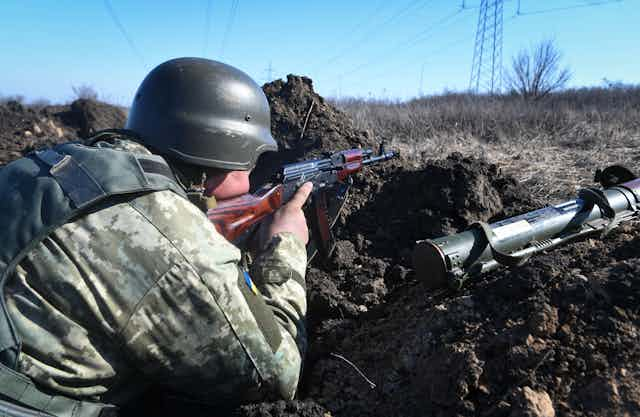The second series of the hugely popular political action thriller Jack Ryan begins with a CIA analyst teaching new recruits to stop relying on the news as a source of intel for what’s going on in war. That’s because we can never know first hand what soldiers face in conflict.
But we do know it is often traumatic. Luckily, psychological research can help explain how likely they are to be able to cope – and how to prevent problems such as post-traumatic stress disorder (PTSD).
Soldiers, such as those serving in Ukraine, are at high risk of developing PTSD. It is the crippling stress reaction where memories of trauma hijack the mind, make sufferers feel highly alert, unsafe, exhausted, on edge and as though they are permanently changed for the worse.
After trauma, PTSD is the gateway through which other problems take root. Up to 80% of people who get PTSD will also develop other difficulties, such as anxiety disorders, depression, substance use and in worst case scenarios, death by suicide. Whether mild or severe, PTSD can have a devastating impact on troops and their families.
To understand how this happens, scientists have turned their attention to high-risk occupational groups, like military personnel and emergency responders. These people are typically assessed before they are deployed and then regularly afterwards. This approach also helps researchers develop interventions that could transform early signs of vulnerability to developing PTSD.
Such an approach has worked well in medicine before. Smoking, for example, was identified as a risk factor for lung cancer, a discovery that led to a range of interventions to help people quit.
But does targeting psychological risk inoculate against severe stress?
A ground-breaking study from the University of Melbourne with the Australian Department of Defence looked at over 5,000 military recruits for the first three-to-four years of their careers. They discovered three key findings.
First, mental health symptoms emerge early in the military lifecycle. This means that people who are likely to struggle can be spotted and offered help early on.
The researchers also identified many predictors of PTSD, such as self-criticsm, self-blame, anger and problems sleeping. However, they found that these were modifiable – they could potentially be changed with training.
But the team also discovered predictors of resilience – what keeps soldiers well. These related to social support from friends, family and work, as well as “adaptive coping styles”, such as being able to accept the reality of difficult events, trying to see challenging events in a different light, and reaching out for support.
Modern militaries, such as in the UK and US, offer access to a range of first-line treatments for PTSD. But preventative interventions are in their infancy and require robust evaluation before they can be rolled out.
We’ve analysed interventions aimed at improving resilience to stress for first responders. We found that the ones most likely to be effective are those which target risk factors that could be changed with training.
Helping Ukrainian soldiers
The war in Ukraine broke out rather suddenly, and many soldiers in the war haven’t had actual military training. That makes them more likely to develop difficulties since lack of good training for deployment increases the risk for mental health difficulties including PTSD. Another problem is that, whenever the war ends, the soldiers will return to a destroyed country, which may lack the resources for targeted psychological training and support.

So how can science help reduce risk of PTSD for soldiers in Ukraine? Social support is going to be hugely important to their health. Knowing what blocks military members from leaning on friends, family and their units can help to break down barriers.
Research from King’s College London (KCL) discovered that stigma around showing emotions and asking for help can be an obstacle. Overcoming this stigma is clearly important in protecting troops from developing longstanding problems. Leaders have a key role here.
Another KCL study found that troops who report experiencing good leadership have around a tenth of the rate of suspected PTSD relative to troops who do not. What’s more, military personnel who perceive their leader to be supportive and effective have a higher chance of seeking help from friends, family or professionals in the event that they go on to develop a mental health problem.
Good leaders who encourage people to seek help are therefore needed in Ukraine, as are interventions that target risk as well as symptoms. Interventions should go beyond the provision of information, commonly called psychoeducation, since these approaches, in isolation, are ineffective at reducing risk for mental health problems in troops.
Crucially, people who are at risk of developing problems should be offered cognitive behavioural interventions which helps them update their thinking and the behaviour that keeps them stuck. This could help them improve their sleep, manage anger, and alter how they interpret difficult events – such as not blaming themselves. And these are all early risk factors among troops for later PTSD.
But the measures are not going to work for everyone, and we need more research to help us understand why that is.
Rigorous assessments of who will develop problems – and which combination of predictors increases the odds of recovering with treatment – will ultimately move the field in the direction of personalised medicine for military members.
Drilling into data to investigate what makes interventions effective and for whom, will guide improvements so they become more precise and effective. Medicine has developed sophisticated algorithms rooted in evidence for guiding the delivery of cancer treatments to improve recovery and survival rates. We must apply similar logic and methods to develop algorithms to guide interventions for military troops and their families.
Soldiers, like emergency responders, dedicate their lives to improving public safety and health. They deserve interventions that work.

